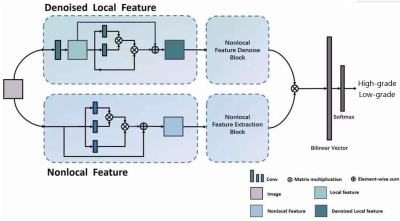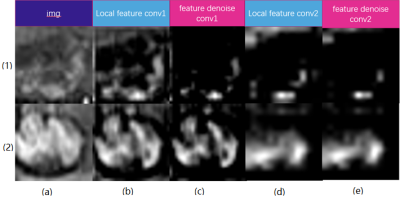0815
Local feature denoising and global feature extraction for malignancy characterization of hepatocellular carcinoma1School of Medical Information Engineering, Guangzhou University of Chinese Medicine, Guangzhou, China, 2Department of Radiology, Guangdong General Hospital, Guangzhou, China
Synopsis
Convolutional neural network (CNN) has been regarded to be powerful for lesion characterization in clinical practice. However, local deep feature derived from CNN has two main shortcomings for characterization. First, the convolutional operations typically process within a local neighborhood while ignoring the global dependency. Furthermore, it is unstable to small perturbations in images (e.g., noise or artifacts). Therefore, we propose a denoised local fusion and nonlocal deep feature fusion method to alleviate the above two problems. The proposed method is a general module, which can be integrated into any CNN-based architecture for improving performance of lesion characterization in clinical routine.
INTRODUCTION
Malignancy of Hepatocellular carcinoma (HCC) is an important prognostic factor that affects recurrence and survival after liver transplantation or surgical resection in clinical practice1. Convolutional neural network (CNN) has been regarded to have powerful ability to characterize the biological aggressiveness of HCC2. However, the convolutional operations typically process within a local neighborhood while ignoring the global dependency, which may lower the capability of deep feature derived from CNN for lesion characterization3. Furthermore, small perturbations to images (e.g., noise or artifacts) may lead to substantial noise in deep feature of CNN systems so as to make incorrect predictions due to the variations and complexities of image content4. In this work, inspired by the work of nonlocal neural network in computer vision5, we propose a denoised local deep feature and nonlocal deep feature fusion method based on the nonlocal neural network in order to rise to the above two challenges for lesion characterization.METHODS
This study has been approved by the local institutional review board, and the informed consent of patients was waived. 115 pathologically confirmed HCC lesions in 112 patients from October 2012 to October 2018 were included in this retrospective study. All MR examinations were performed using a 3.0Tesla(T) MR scanner, in which unenhanced, arterial, portal venous, and delayed phase images were acquired using the breath-hold Axial LAVA+C sequence. Of the 115 HCCs, fifty-four low-grade tumors correspond to Edmondson grade I and II, and sixty-one high-grade tumors correspond to Edmondson grade III and IV. Figure 1 shows the proposed denoised local and nonlocal deep feature fusion framework, which is mainly composed of three modules: denoised local feature extraction, non-local feature extraction and bilinear kernel fusion. For the procedure of denoised local deep feature extraction, a non-local denoising block is conducted to generate the denoised local features. Then, the nonlocal deep feature is effectively extracted from the original tumor images by the nonlocal feature extraction block. Finally, the denoised local deep feature and the nonlocal features are fused by the bilinear kernel method to output the classification result. Note that the training (75 HCC) and independent testing (40 HCC) data were obtained from the arterial phase and were repetitively performed five times in order to reduce measurement errors. Values of the metric including the accuracy, sensitivity and specificity in the five repetitive tests were calculated and denoted as the representation of mean±std.RESULTS
Table 1 showed the characterization performance of different models for malignancy characterization of HCC. Compared with local feature generated by the CNN baseline 2, the GAP CNN with global feature3 and the Nonlocal CNN5 have better results. Specifically, the Nonlocal CNN outperforms the GAP CNN for global information extraction. Finally, the denoised CNN4 obtains largest performance gain over the CNN baseline. As shown in Table 2, we can find that all the fusion methods yield improved performance compared with the single CNN, while the proposed denoised local and nonlocal feature fusion by the bilinear kernel method results in highest performance. Figure 2 shows a set of the feature maps in different models for two representative HCC samples. We can clearly observe that the local feature maps are smoothed and high-lighted by the nonlocal operations to generate denoised local deep feature. Figure 3 shows the loss curves and the corresponding accuracy curves for different models. Our proposed model (NL+FD (Bilinear)) exhibits consistent better performance than the CNN baseline2, nonlocal feature(NL) 5, denoised local feature(FD+CNN)4, and the local and nonlocal feature fusion (NL+CNN(C+I)) 6throughout the testing procedure.DISCUSSION
The present study suggests that the global information can obtained better performance than the local deep feature for lesion characterization. As the global deep feature reflects the global dependency of features within the lesion region, it is supposed to be more representative and robust to large variations and complexities in image content. We further demonstrate that the denoising of local deep feature outperforms the local deep feature for lesion characterization. To our best knowledge, the present study might be the first work to indicate the significance of local feature denoising in deep learning for lesion characterization. As the process of lesion imaging is generally subject to noise and image artifacts, deep features derived from CNN might be contaminated by those perturbations in medical images. More importantly, the visualization of feature maps in the model indicates that the denoised local feature map exhibits salient regions and noise reduction while suppressing unnecessary features. In addition, our study also demonstrates that the fusion of denoised local feature and the nonlocal feature yields best results for lesion characterization, verifying that the local information and global information are complementary for improving characterization performance of CNN 3,6.CONCLUSION
Our present study demonstrates that the denoising of the local feature, the extraction of global information can both yield better performance than the conventional CNN baseline for malignancy characterization of HCC. Furthermore, the fusion of denoised local and nonlocal deep feature by the bilinear kernel method can achieve best results for lesion characterization, outperforming several recently proposed methods. The proposed method is a general module, which can be integrated into any CNN-based architecture for improving performance of lesion characterization in clinical routine.Acknowledgements
This research is sponsored by the grant from National Natural Science Foundation of China (81771920).References
[1] Haratake J, Takeda S, Kasai T, Nakano S, Tokui N. Predictable factors for estimation prognosis of patients after resection of hepatocellular carcinoma. Cancer 1993;72: 1178-1183.
[2] Zhou W, Wang G, Xie G, Zhang L. Grading of hepatocellular carcinoma based on diffusion weighted images with multiple b-values using convolutional neural networks. Medical Physics 2019;46(9): 3951-3960.
[3] Qiu Z, Yao T, Ngo C, Tian X, Mei T. Learning Spatial-temporal representation with local and global diffusion. Proc. IEEE Int. Conf. Computer Vision and Pattern Recognition (CVPR) 2019:12056-12065.
[4] Xie C, Wu Y, Maaten L, Yuille A, He K. Feature Denoising for Improving Adversarial Robustness. Proc. IEEE Int. Conf. Computer Vision and Pattern Recognition (CVPR) 2019:501-509.
[5] Wang X, Girshick R, Gupta A, He K. Non-local Neural Networks. Proc. IEEE Int. Conf. Computer Vision and Pattern Recognition (CVPR) 2018:7794-7803.
[6] Dou T, Zhang L, Zheng H, Zhou W. Local and nonlocal deep feature fusion for malignancy characterization of hepatocellular carcinoma. Int. Conf. Medical Image Computing and Computer Assisted Intervention, 2018: 472-479.
Figures




